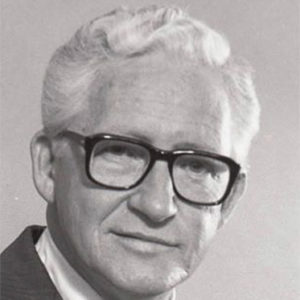calsfoundation@cals.org
Carl Max Milam (1930–1987)
Carl Max Milam was a printing plant superintendent, a university professor and department chairman, the director of a major Arkansas state government agency under two governors, the financial manager for Winthrop Rockefeller, a university president, and a business executive. A branch library of the Central Arkansas Library System (CALS) and a scholarship at the University of Arkansas at Little Rock (UA Little Rock) were named in his honor.
Max Milam was born on July 13, 1930, in Cecil (Franklin County) to Carl J. Milam and Letha Staton Milam. He graduated from high school in Fort Smith (Sebastian County). After high school and in between college enrollments, he worked as a printer and plant superintendent. He received a bachelor’s degree in political science from Oklahoma Baptist University in Shawnee, Oklahoma, in 1954. Milam was awarded both a master’s and a doctorate degree in political science from the University of Oklahoma in Norman, finishing in 1961.
He married Marilyn Jean Cline of Fort Smith in his teenage years. They had three daughters.
Milam served on the faculty at the University of Kentucky and received a commendation from the state legislature for his assistance. Moving to the University of Arkansas (UA) in Fayetteville (Washington County) in 1966, he became chairman of the Department of Political Science and founded the university’s graduate public administration program.
In February 1969, Governor Winthrop Rockefeller circulated a plan for a major reorganization of the state government’s executive branch. The plan was designed by Milam. Republican Rockefeller proposed the plan to the Democratic-controlled Arkansas General Assembly but was not successful in having it adopted.
In September 1969, Milam received a two-year leave of absence from the university and accepted the Rockefeller appointment as director of the Arkansas Department of Administration. Milam continued in that position under Governor Dale Bumpers, who had defeated Rockefeller in the 1970 election. Initially, Bumpers said that, if elected, he would fire Milam. But after Bumpers learned that they had both lived in Franklin County and were about the same age, he realized that he had once known Milam by the first name of Carl. They were reacquainted and became good friends. After his election, Bumpers asked the University of Arkansas Board of Trustees to extend Milam’s leave of absence so that he could remain in his position for another year. Bumpers persuaded the legislature to implement a major reorganization of state agencies based on Milam’s plan; this became Act 38 of 1971. This act engendered a realignment and consolidation of departments and agencies and was recognized as improving efficiency.
While in state government, Milam was an outspoken advocate for progressive taxation, regional health centers, the creation of the Central Arkansas Radiation Therapy Institute (CARTI), and constitutional revision. Sometimes described as controversial, he was frequently in disagreement with agency heads and legislators but was effective in implementing the governor’s policies. He helped bring more authority and fiscal control to the governor’s office and improved policies for the investment of state funds. A newspaper article headline in October 1971 stated, “Next to Governor; Fiscal Officer Is Most Powerful.”
In 1972, Milam resigned as director of what had become the Department of Finance and Administration to take the position of chairman of Winthrop Rockefeller and Associates, becoming Rockefeller’s primary finance manager. Upon the death of Rockefeller in 1973, Milam became executor of the estate and a trustee of the Winthrop Rockefeller Trust.
In 1974, he was elected president of the University of Nevada at Reno. He served there until 1978 and then was senior vice president at Del Webb Corp. in Nevada until 1981. He returned to Arkansas, settling in Houston (Perry County) in 1982. After returning to Arkansas, he was general manager of Planters Lumber Company, which operated in Arkansas and Mississippi and was a subsidiary of Rockefeller Enterprises.
Milam was described as being “hands on” in all of his activities. He built a sailboat and a cabin on Beaver Lake while in Fayetteville. When he and his family moved to their farm in Houston, he built the home and barn himself. His wife raised Arabian horses on their farm.
Milam died on April 15, 1987, at age fifty-six in Houston. He had been a guest lecturer at UA Little Rock, and his daughter Sherry was on the faculty there. After his death, a memorial fund was established for a scholarship named for him. His contributions to the Perry County community were recognized when the new Perryville (Perry County) branch of the Central Arkansas Library System, funded in part by the Rockefeller Foundation, was named for him in 1993.
For additional information:
Dumas, Ernest. “Milam Resigns State Job; Will Take ‘Career’ Position with Rockefeller.” Arkansas Gazette, January 19, 1972, pp. 1A, 2A.
———. “Next to the Governor; Fiscal Officer Is Most Powerful.” Arkansas Gazette, October 24, 1971, p. 19A.
Goss, Kay Collett. The Arkansas State Constitution. Oxford Commentaries of the State Constitutions of the United States. New York: Oxford University Press, 2001.
“It’s Up to Board, But Bumpers Asks Milam to Remain.” Arkansas Gazette, May 4, 1971, p. 7A.
“Plan to Reorganize State Agencies Unveiled.” Northwest Arkansas Times, February 12, 1969, p. 8.
“Planner of Reorganization of State Agencies Dies.” Arkansas Gazette, April 16, 1987, p. 17A.
“UA Professor Selected to Assume Frost’s Job; ESD Director Shifted.” Arkansas Gazette, August 31, 1969, p. 6A.
W. W. Satterfield
Little Rock, Arkansas
 Central Arkansas Library System
Central Arkansas Library System Divergent Prosperity and the Arc of Reform, 1968–2022
Divergent Prosperity and the Arc of Reform, 1968–2022 Politics and Government
Politics and Government Milam Library
Milam Library  Max Milam
Max Milam  Max Milam
Max Milam 




Comments
No comments on this entry yet.